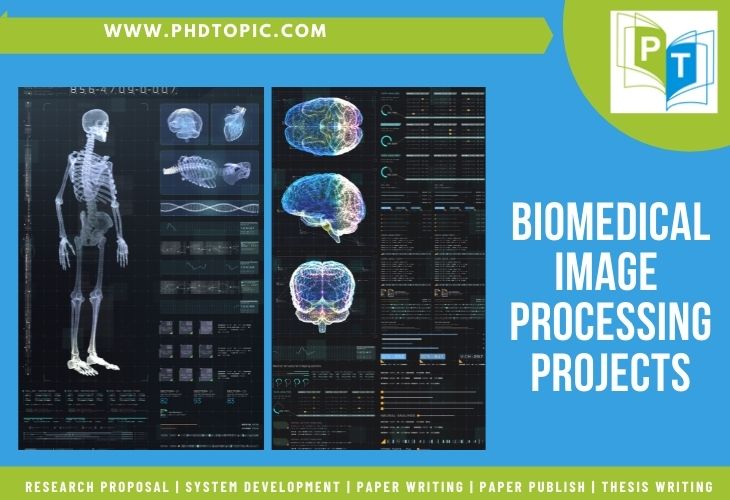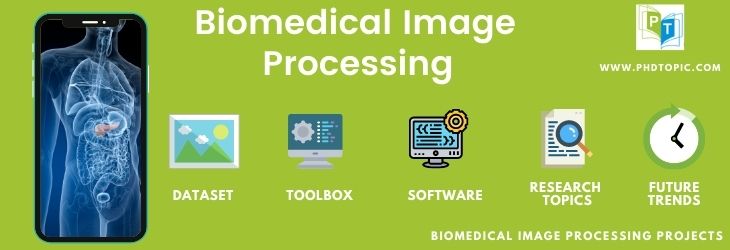Biomedical image processing projects deals with analyzing of captured internal human body images for clinical treatment and diagnosis. The information of physiological and physiology processes are collected through advanced sensors and processed by suitable computing technology. There are several methodologies to study the present state and disorder of specific human organs/tissue.
For this, it utilizes the following different types of biomedical images. And, they are:
- Ultrasound (sound)
- MRI (magnetism)
- CT scans (x-rays)
- OCT and Endoscopy (light)
- SPECT and PET (nuclear medicine: radioactive pharmaceuticals)
The handling of medical imaging is performed by the computerized system through efficient techniques and algorithms. As well, these techniques are incorporated with many advantages such as scalability, reliability, adaptability, privacy and etc. In general, imaging processes consist of image acquisition, computing, communication, storage, and visualization.
For your information, we shared the summary of the fundamentals of biomedical image processing. All these data make you understand the important terminologies, recent imaging modalities, image processing procedure, formation of medical image, and other futuristic image processing methodologies. Here, we have itemized the expected future developments by our expert’s suggestion.
Let’s have a quick glance over the recent research developments in medical image processing. These areas gain the attention of current active scholars who are pursuing their research careers in the bio-medical image processing research field.
Top 20 Major Research Topics in Biomedical Image Processing
Below we have mentioned most interesting biomedical image processing projects, we can guide you to formulate best research topics based on biomedical; reach us to know more information.
- Advances in Medical Image Computation
- Registration and Fusion of 3D Multimodal Medical Image
- Virtual and Augmented Reality in Medical Applications
- X-Ray Phase Contrast Technology and Tomography
- Automatic 3D Lungs Segmentation in Chest Scan
- 3D Superpixels Computation on Volumetric Intensity Image
- Deep Conventional Networks for Single Image Super-Resolution
- Partitioning 3D surface in Multi-modality Medical Imaging
- Medical Image Registration, Processing and Analysis
- Real-time Ultrasound, MRI and CT Imaging and Investigation
- Improved Non-Radioisotope Imaging Analysis
- Impact of Digital Image Communication in Medicine (DICOM)
- Segmentation of MR image Intensity Inhomogeneity
- Classify Huge-scale Multi-resolution Images using Deep Learning
- Deep Learning Model based 3D based Brain Tumor Segmentation
- Fast Wavelet based Normalized MRI Reconstruction
- Accuracy in Teeth Structures Segmentation on MRI and CT Images
- Techniques and Applications of Magnetic Resonance Imaging (MRI)
- Implementation of DL Algorithms over Multimodal Images for Semantic Segmentation
- Security Challenges in Storing and Exchanging Medical Information

Future Trends in Medical Imaging
- Real Implication of Retinal Diseases
- Wireless Tiny Single-Chip Ultrasound Sensing
- Rise of Artificial Intelligence (AI) in Radiology
- Heart or Cardiovascular Imaging Technology
- Future of Ultrasound Device and System Portability
- Large Superconducting Magnet System Applications
- 4D Printing Bio-medical Models and Applications
- Development of MRIs between Slow and Fast Fuzzy
- 3D Mathematical and Anatomical Models
- Migration and Advancement of X-Rays Films into Digital Files
- Skull Stripping Brain Tumor Segmentation
Based on our recent research on image processing over current journals, we found that most of the scholars are interested in using image datasets like spatial scales, which range from cellular/molecular imaging to organ/tissue imaging for their proposed topics. Other than this, scholars are familiar with the dataset from the followings,
- X-ray
- Colon Cancer
- Lesion
- Nuclear Medicine
- Computerized Tomography
- Ultrasound
- Magnetic Resonance
- Confocal and Optical Microscopy
- Diabetic Retinopathy
- Range Image and Video Data sets
- Radiology
- Computed Tomography (CT)
- Nuclear Magnetic Resonance (NMR)
For your knowledge, we have enumerated some datasets that are popularly used in developing Biomedical Image Processing Projects. Further, we have grouped the following based on category, modalities, network type with their corresponding datasets for your ease.
Datasets for Medical Image Modalities
- Cardiac
- Modalities: MRI
- Network Type: LU-Net
- Data Set: ACDC Stacom 2017
- Chest
- Modalities: CT, CXR and MRI
- Network Type: FCN, SCAN, dense-FCN and U-Net
- Data set: JSRT, Montgomery, JSRT, 172 sparsely annotated CT scan data set, TCIA, NSCLC
- Cell
- Modalities: Microscopic
- Network Type: SegNet
- Data Set: ALL-IDB1 database
- Brain
- Modalities: MRI
- Network Type: 3D U-Net, FCN, cGAN, V-Net, 3d FCN, SegAN-CAT and GAN
- Data Set: MRBrainS13, 62 Healthy Brain Images, BRATS2015, BRATS2017, BRATS2018, BRATS2019, Infant Brain Images, ANDI and NITRC data set
- Whole Heart
- Modalities: CT
- Network Type: 3D U-Net and CFUN
- Data Set: MICCAI 2017 whole heart and MM-WHS2017
- Eye
- Modalities: Funduscopy
- Network Type: GAN, PixelBNN, FCN, Res-UNet and U-Net
- Data Set: STARE, DRIVE, RIM-ONE, CHASEDB1 and Drishti-GS data set
- Kidney
- Modalities: CT
- Network Type: Kid-Net
- Data Set – 236 Subjects
- Spleen
- Modalities: MRI
- Network Type: SSNet
- Data Set: 60 abdominal MRI Scans
- Left Ventricles
- Modalities: 3D echocardiography
- Network Type: VoxelAtlasGAN
- Data Set: 60 Subjects over 3D echocardiography
- Pancreas
- Modalities: CT
- Network Type: Attention U-Net
- Data Set: TCIA
- Left and Right Ventricles
- Modalities: MRI
- Network Type: FCN
- Data Set: LVSC, RVSC and SCD
- Skin
- Modalities: Dermoscopy
- Network Type: FCN and GAN
- Data Set: ISBI 2017 and DermoFit
- Left Atrium
- Modalities: MRI
- Network Type: 3D U-Net
- Data Set: LASC2018
- Liver
- Modalities: MRI and CT
- Network Type: DI2IN-AN, FCN and DCNN
- Data Set: 1000 CT volumes, LiTS, 3DIRCADb and others
- Musculoskeletal
- Modalities: MRI
- Network Type: SegNet
- Data Set: MICCAI Challenge Data Set
- Basal Membrane
- Modalities: Histopathology
- Network Type: GAN
- Data Set: IPMCH
- Prostate
- Modalities: MRI
- Network Type: FCN, V-Net, USE-Net,
- Data Set: 152 MRI images, 3 T2-weighted MRI data sets and PROMISE2012
- Spines
- Modalities: MRI and CT
- Network Type: Spine-GAN and Btrfly Net
- Data Set: 253 multi-center medical patients and 302 CT Scan
For instance: In order to identify the tumor patterns/features, several improved ML algorithms are used for spatial and temporal analysis. Also, it enables to find of the organ/tumor (vasculature, volume, and diameter), fluid/blood flow parameters, and microscopic changes based on the selected appropriate imaging approaches used in wireless body area network projects.

This article is specifically discussed research trends in Biomedical Image Processing Projects along with their technological advancements!!!
Biomedical Image Processing Toolboxes
- Image Acquisition Toolbox
- Mapping Toolbox
- Image Processing Toolbox
- Medical Image Processing Toolbox
- Deep Learning Toolbox
- Computer / Machine Vision Toolbox
- Vision HDL Toolbox
Next, we can see the significant development tools and software for implementing any kind of Biomedical Image Processing projects. More than this, there exist many technologies. So, one should choose the optimal tool based on the requirements of the handpicked project.
Development Tools and Software’s for Biomedical Image Processing
- Fiji
- MATLAB
- Python
- ImageJ
- MITK
- ITK
- Amira
- LEADTOOLS
- 3Dslicer
- MIPAV
- MeVisLab
In recent research, our experts have recognized image informatics and cloud computing as the top-demanding research fields by scholars. Also, we just want you to know the other important research areas from the followings,
Cloud based Topics in Medical Image Processing
- Cloud assisted Medical Imaging Services for Social Medias
- Virtual Setting in Mammogram Testing and Interpretation
- MIIP: Web Solution for Medical Image Analysis and Understanding
- Crowdsourcing based Virtual Colonoscopy Video Analysis (For instances: polyp identification and annotation)
In addition, we have also given you the latest image informatics application in the healthcare sector for illustration purposes. Beyond this, it spreads its fame in all many research fields.
Image Informatics Healthcare Applications
- Applying Local Global Classifier for Screening Chest X-Rays
- Digital Pathology Image Analysis using Advanced DNN classification
- 3D-CNN based Malignant Breast Cancer Identification in MR images
- Frequency assisted Human Brain Network Similarity Detection
- DAX Next Generation is near to 1 million processes over commodity hardware
- Automated Thyroid Segmentation in 3D Ultrasound Images
- CBIR based Automatic Multi-Label Annotation in Abdominal CT images
- Blood Vessels Inpainting based on Optic Disc / Cup Segmentation Methodologies
On the whole, we are glad to give our end-to-end research guidance on Biomedical Image Processing Projects topic under the supervision of our technical experts. So, make use of this opportunity and hold your hand with us to create a masterpiece of research.
